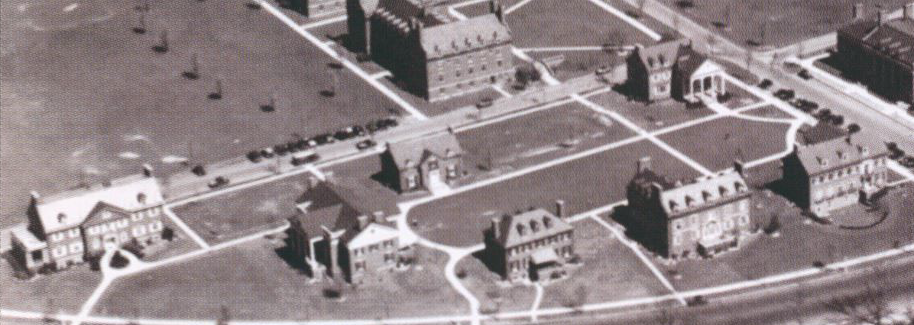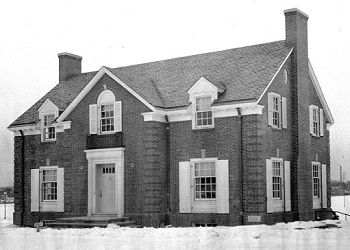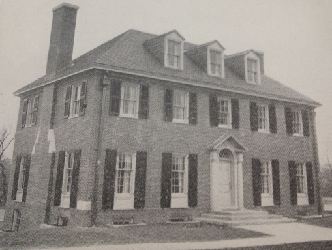
| River Campus | Fraternities |
 |
| Fraternity Quad in
1931 |
Several fraternities owned houses near the Prince Street Campus and when the new River Campus for Men was opened in 1930 space was reserved for nine fraternity houses on campus. President Rush Rhees proposed that the University assign a plot of ground to each fraternity in return for a nominal payment. Designs of homes would be subject to review and approval by University architects, and limitations would be placed on the amount that might be expended on buildings; heat, water, and light moreover, would be furnished to the houses on a metered basis. If desired, the U. of R. would loan each fraternity up to half the cost of construction, but it reserved the right to take over any property at any time with reasonable compensation for the fraternity equity. With alacrity the Greeks accepted this generous agenda.
Seven buildings were completed or under construction when the new campus was dedicated in October 1930.
| 1930 | Psi Upsilon, opened October 5, 1930 | |
| 1930 | Delta Kappa Epsilon, opened November 1, 1930 | |
| 1931 | Sigma Delta Epsilon (Now Sigma Chi), opened January 1931 |  |
| 1931 | Theta Delta Chi (Quad Annex; Community Learning Center; Sigma Phi Epsilon), opened January 1931 | |
| 1931 | Alpha Delta Phi, opened Spring 1931 | |
| 1931 |
Delta Upsilon (Drama House), Opened
October 10, 1931 |
|
| 1931 | Theta Chi, Opened October 20, 1931. In the early 1950s the brotherhood successfully raised funds to add a new wing to the Chapter House. The official Memorial Wing was erected in 1953 and was dedicated on June 11th, 1954 to the five brothers who lost their lives during the Second World War. The Memorial Wing added three bedrooms to the House, bringing the total number of bedrooms to twelve. The Memorial Wing also greatly increased the size of the living room, dining room, and attic areas. The next major improvement occurred in 1982 due to a $250,000 gift pledged by the late C. Grandison Hoyt ’24. The gift provided for a full renovation of the kitchen and a variety of other repairs and furnishings. Thanks to generous donations pledged by Alpha Zeta alumni through the ongoing Capital Campaign, a major renovation was completed in 2010, bringing the House up to State health and safety codes and providing for complete restoration of the interior. |
 |
| 1955 | Kappa Nu (after 1961 Phi Epsilon Pi; Delta Upsilon; Medieval House; Douglass Leadership House), Opened November 11, 1955 | |
| 1966 | Sigma Alpha Mu, opened December, 1965 |
References
1924 "University Plans
Mingling Houses of Fraternities with Dormitories on New Campus," Democrat
and Chronicle, July 18, 1924, Page 23.
1929 "Fraternities
Will Discuss New U.R. Hall," Democrat and Chronicle, January
5, 1929, Page 14.
Campus Dining Facilities main problem for group meeting Monday night.
1929 "Plan for Fraternity House of Theta Delta Chi," Democrat and Chronicle, December 4, 1929, Page 19.
1930 "Psi
Upsilon Foundation Works to begin," Democrat and Chronicle,
March 2, 1930, Page 7.
Fraternity House on New Campus to be built by August 1.
1930 "First
Plans Drawn for Chapter House," Democrat and Chronicle, July
26, 1930, Page 21.
Preliminary plans have been approved for the construction of the new Sigma
Delta Epsilon fraternity house on the new River campus of the University
of Rochester. When finally formulated architect's plans will call for a
two-story chapter house with basement. It will be in the Georgian style,
In keeping with that employed by the other fraternities and In the new
University buildings. In its location on "fraternity quad," the Sigma Delt
house wiil face Harbor Boulevard although an additional row of fraternity
houses will be built between the building and the boulevard. When begun,
this will make a total or four new fraternity houses under present
construction.
1930 "University
May Own Fraternity Houses," Democrat and Chronicle, December
4, 1930, Page 11.
Any such move would be for the purpose of escaping a heavy city tax and
thus remove a heavy burden from the active members of the fraternities, it
is said.
1955 "Work Begun on $100,000 Kappa Nu Fraternity House," Rochester Review 16(3):5 (January 1955)
1966 "Dean Cole, Jackson Tell Fraternities of Quad Plans," Campus Times, December 2, 1966, Page 1.
1975 "UR
weighing future of its fraternities," Democrat and Chronicle,
February 26, 1975, Page 1B.
The University of Rochester is considering a proposal to tear down all
nine of its fraternity and group living houses on the River Campus and
replace them with dormitories.
1977 History
of the University of Rochester, 1850-1962, by Arthur J.
May. Expanded edition with notes
Chapter 22, Oak Hill Becomes River Campus
The northwestern portion of the campus, immediately in front of Todd
Union, was set aside for homes of the fraternities. Almost as soon as
removal to Oak Hill came under serious discussion, leaders of the Greek
societies engaged in conferences with administrative officials on future
houses, and a special committee made up representatives of the
fraternities was formed. The trustees assenting, Rhees proposed to the
committee that the University assign a plot of ground to each fraternity
in return for a nominal payment. Designs of homes would be subject to
review and approval by University architects, and limitations would be
placed on the amount that might be expended on buildings; heat, water, and
light moreover, would be furnished to the houses on a metered basis. If
desired, the U. of R. would loan each fraternity up to half the cost of
construction, but it reserved the right to take over any property at any
time with reasonable compensation for the fraternity equity. With alacrity
the Greeks accepted this generous agenda.
As plans unfolded, $60,000 was set as the maximum that might be spent on a
house, exclusive of furnishings. It was understood, too, that sleeping
quarters should accommodate no more than twelve men, and that no dining
facilities should be provided, but the last point was dropped in deference
to undergraduate wishes.
Nine parcels were blocked out, most of them surrounding what came to be
known as the Fraternity Quadrangle, and drawings by lot were held to
determine the location of homes for seven of the ten fraternities which
desired to build. A building committee of each Greek society engaged an
architect, decided on the design of the new home, and organized an appeal
among the brothers for construction funds. Alpha Delta Phi, for example,
issued a pamphlet describing the plans for its house and reminding the
alumni, "This is not the House that Jack built--but the house that YOUR
JACK must build."
Despite the Great Depression, vigorous fund-raising drives yielded
gratifying results. Young Sigma Delta Epsilon, by way of illustration,
which counted only eighty-nine alumni on its rolls, contrived to collect
about $16,000; the University extended a loan in the same amount and up
the house went, graduates with clever hands putting the finishing touches
on the interior.
The building committee of Alpha Delta Phi estimated that the Prince Street
property of the fraternity could be sold for at least $45,000 and that
much more would be subscribed by graduates. Those calculations, alas, were
partly upset by the coming of the Depression, yet some 275 out of 367
living alumni (including practically every graduate living in Rochester)
pledged upwards of $53,000 to be paid in installments over five years,
and, though there was no market for the Prince Street house a bank loan of
$20,000 on it was obtained. An auction of the furniture added a princely
$73.10 to the building fund; when finally sold the property netted less
than $22,000. A window showing the Alpha Delt emblem was removed to the
new home, whose total cost amounted to nearly $86,000, of which over
$68,000 went for construction and the rest for furnishings and equipment.
By the end of 1951 seven Greek bodies had been installed in attractive
residences, representing, happily, a variety in form, shape, and
distinctive internal arrangements. As prescribed, the plans had been
approved by U. of R. representatives, and on paper, at least, the
University owned the seven houses which with equipment cost about
$450,000. Besides, the University purchased four fraternity homes near the
Prince Street Campus, and University loans on houses together with a few
subsequent loans amounted to almost $225,000.
No more house construction took place until 1955, when Kappa Nu (after
1961 Phi Epsilon Pi) erected a dwelling on the Fraternity Quadrangle.
Alpha Phi Delta and Beta Delta Gamma acquired homes on Scottsville Road
and Elmwood Avenue, respectively, a few minutes walk from the campus.
1979 "Frat tax issue is settled, UR wins," Campus Times, September 14, 1979, Page 1.
1980 "Frat quad renovation announced," Campus Times, November 6, 1980, Page 1.
1982 "Greek Revival," Democrat and Chronicle, June 26, 1982, Page 1B. | Part 2 |
1983 "Greek Revival," Rochester Review 45(2):14-15 (Winter 1983)
1983 "Greek Renaissance at the U of R.," Democrat and Chronicle, April 10, 1983, Page 1C.
© 2021 Morris A. Pierce